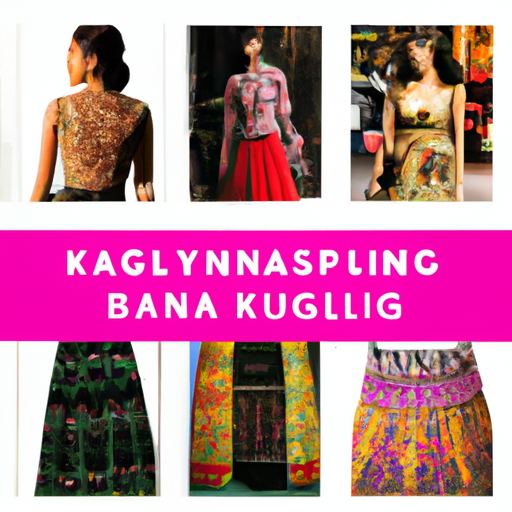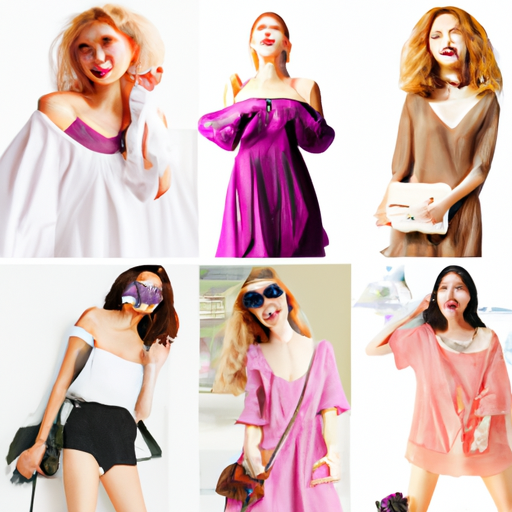Fashion Trends Southeast Asia
You’re about to discover the latest and most captivating fashion trends in Southeast Asia. From vibrant colors and intricate patterns to bold accessories and unique styles, this article will take you on a fashion journey through the diverse and thriving fashion scenes of countries like Thailand, Malaysia, Vietnam, and Indonesia. Get ready to be inspired by the fusion of traditional elements with modern twists, as Southeast Asia continues to redefine and reinvent the world of fashion.

Table of Contents
Traditional Southeast Asian Fashion
Southeast Asia is a region known for its rich cultural heritage, and this is beautifully reflected in its traditional fashion. From the elegant Baju Kurung of Malaysia and Indonesia to the exquisite Cheongsam of China, each garment carries with it a unique story and identity. The Baju Kurung, a loose-fitting tunic worn over a skirt, is a popular choice for formal occasions and weddings. Its graceful design and vibrant colors make it a true symbol of Southeast Asian fashion.
The Cheongsam, on the other hand, is a form-fitting dress that originated in China but has become an integral part of Southeast Asian fashion. With its high collar and intricate embroidery, the Cheongsam exudes elegance and femininity. It has been embraced by women in countries like Malaysia and Singapore, who wear it with pride.
In Cambodia, the Sampot is a traditional garment that is draped around the body and secured at the waist. Its versatility allows it to be worn as a dress, skirt, or even pants. The Sampot reflects the longstanding heritage and cultural traditions of Cambodia.
In Laos, the Sinh is the traditional dress worn by women. It is a tube-like garment made from silk and worn with a silk blouse. The Sinh is often adorned with intricate patterns and bright colors, showcasing the exquisite craftsmanship of Laotian artisans.
The Baju Melayu is the traditional attire for men in Malaysia and Indonesia. It consists of loose-fitting pants and a matching tunic, often worn with a songkok (a traditional hat). The Baju Melayu is a symbol of masculinity and is commonly worn during religious festivals and celebrations.
Influence of Western Fashion
The influence of Western fashion in Southeast Asia cannot be denied. With the globalization of culture and the rise of social media, young people in the region have been exposed to the latest trends from around the world. As a result, Western fashion has made a significant impact on the local fashion scene.
One of the most noticeable effects of Western influence is the rise of street style in Southeast Asia. Street style has become a global phenomenon, and Southeast Asian cities like Jakarta, Singapore, and Bangkok have embraced this trend wholeheartedly. Young people are now experimenting with bold and eclectic outfits, mixing and matching different styles to create their own unique looks.
Another aspect of Western fashion that has gained popularity in Southeast Asia is denim. Jeans, denim jackets, and denim skirts have become wardrobe staples for many locals. The versatility and durability of denim make it an ideal choice for the region’s tropical climate.
Tailoring has also been adapted from Western fashion in Southeast Asia. Traditional garments are now being tailored to fit modern silhouettes, offering a more contemporary and stylish look. This blend of traditional and modern elements creates a fashion style that is unique to the region.
Athleisure, the fusion of athletic and leisurewear, has also made its way into Southeast Asian fashion. As people prioritize comfort and functionality, sportswear-inspired outfits have become a common sight on the streets. Leggings, hoodies, and sneakers are now being incorporated into everyday outfits, adding a sporty and casual touch.

Emerging Sustainable Fashion
With the growing concern for the environment, Southeast Asia has seen the rise of sustainable fashion. Designers are now exploring eco-friendly textiles and materials, such as organic cotton, bamboo, and recycled polyester. These sustainable fabrics not only reduce the environmental impact but also offer comfort and style.
Upcycling and recycled fashion have also gained traction in the region. Designers and brands are repurposing old garments and materials to create new and unique pieces. From transforming vintage saris into modern dresses to creating accessories from recycled plastics, Southeast Asian designers are finding innovative ways to reduce waste and promote a circular economy.
Supporting local artisans and craftsmanship is another key aspect of sustainable fashion in Southeast Asia. Local communities with rich textile traditions are being empowered through fair trade practices and ethical sourcing. By promoting and preserving indigenous techniques, Southeast Asian fashion designers are not only creating beautiful garments but also preserving cultural heritage.
The Rise of Modest Fashion
Modest fashion has become a global movement, empowering women to express their style while adhering to cultural and religious beliefs. In Southeast Asia, modest fashion is deeply rooted in the region’s diverse religious and cultural practices.
Hijab fashion, in particular, has gained significant popularity in Southeast Asia. Muslim women have embraced this fashion trend, combining modesty with style. Hijabs, which are headscarves worn by Muslim women, are now available in a wide variety of colors, designs, and materials, allowing women to express their individuality while adhering to religious customs.
Long-sleeve and loose-fitting attire, such as maxi dresses, tunics, and wide-leg pants, have also become staples of modest fashion in Southeast Asia. These garments provide coverage while still allowing women to feel comfortable and confident in their outfits.
Modest swimwear, often referred to as burkinis or modest swimsuits, has also emerged as a fashionable option for women who prefer more coverage at the beach or pool. These swimsuits offer UV protection and are designed to be lightweight and water-resistant, making them suitable for water activities.

Thrift Shopping and Vintage Revival
Thrift shopping has become a popular trend in Southeast Asia, offering a sustainable and affordable alternative to fast fashion. Secondhand clothing markets have sprouted up in major cities, providing locals with the opportunity to find unique and vintage pieces.
Retro and vintage fashion has also been revived in the region. From 1950s-inspired dresses to 90s grunge fashion, vintage styles are making a comeback. Thrift shops and online platforms have become treasure troves for fashion enthusiasts who are looking to add a touch of nostalgia to their wardrobe.
Streetwear Culture
Streetwear culture has taken Southeast Asia by storm, becoming a prominent fashion trend among the region’s youth. Influenced by urban fashion from the United States and Japan, Southeast Asian streetwear has developed its own distinct style.
Urban influences can be seen in the oversized silhouettes, baggy pants, and hoodies that have become synonymous with streetwear in the region. Bold logos and graphic prints are also prevalent, adding a statement element to streetwear outfits.
Sneaker culture has also thrived in Southeast Asia. Sneakers have become a fashion staple, worn not only for athletic purposes but also as a fashion statement. Limited-edition releases and collaborations with celebrities or local designers have created a thriving sneaker culture in the region.
Celebrities and Influencers
Celebrities and influencers play a significant role in shaping fashion trends in Southeast Asia. Fashion icons from the region, such as Raya Meddine and Yasmine Yeya, inspire millions of followers with their impeccable style and fashion choices.
Social media influencers have also become a powerful force in the fashion industry. With platforms like Instagram and TikTok, influencers have a direct connection with their followers, influencing their fashion choices and preferences. Brands often collaborate with these influencers to create exclusive collections or promote their products, further driving fashion trends in Southeast Asia.
Collaborations between international brands and local designers have also become more common. Global fashion houses recognize the talent and creativity of Southeast Asian designers and are partnering with them to create unique and culturally-inspired collections. These collaborations not only showcase the rich diversity of Southeast Asian fashion but also open doors for local designers to reach a wider audience.
Traditional Textiles and Patterns
Traditional textiles and patterns are a significant part of Southeast Asian fashion. These fabrics reflect the cultural heritage and craftsmanship of the region.
Batik is one of the most well-known traditional textiles in Southeast Asia. It is a technique of wax-resist dyeing, resulting in intricate patterns and designs. Batik fabrics are commonly used in clothing, accessories, and home decor, adding a touch of tradition and elegance.
Ikat is another traditional textile technique that involves dyeing yarn before it is woven. This results in intricate and bold patterns that are unique to each region. Ikat fabrics are often used in traditional garments, such as sarongs and scarves, showcasing the vibrant and diverse cultures of Southeast Asia.
Songket is a luxurious fabric adorned with metallic threads, traditionally used for ceremonial clothing and special occasions. The intricate motifs and shimmering effect of songket make it highly sought after. This fabric adds a touch of opulence and glamour to Southeast Asian fashion.
Lao Silk is a fine silk fabric known for its softness and intricate patterns. It is traditionally handwoven by skilled artisans in Laos, showcasing the rich cultural heritage of the country. Lao Silk is often used in traditional dresses, scarves, and home furnishings, adding a touch of elegance to any outfit or space.
Innovative Fashion Designers
Southeast Asia is home to a vibrant and creative fashion scene. The region has produced numerous talented designers who have made a name for themselves both locally and internationally.
Avant-garde fashion has found a niche in Southeast Asia, with designers pushing the boundaries of traditional fashion. They experiment with unconventional materials, innovative silhouettes, and thought-provoking concepts, creating pieces that challenge societal norms and expectations.
Cross-cultural collaborations between Southeast Asian designers and international fashion houses have also become increasingly prevalent. These collaborations blend traditional elements with modern design aesthetics, resulting in unique and culturally-inspired collections. They not only celebrate the rich heritage of Southeast Asia but also showcase the region’s creative talent on a global stage.
Fashion Weeks and Events
Fashion weeks and events have become an integral part of the Southeast Asian fashion calendar. They serve as platforms for designers to showcase their latest collections, attracting fashion enthusiasts, buyers, and industry professionals from around the world.
Jakarta Fashion Week, held annually in Indonesia, is one of the region’s premier fashion events. It showcases the best of Indonesian fashion, highlighting the country’s rich textile traditions and emerging designers.
Singapore Fashion Week is another highly anticipated event in Southeast Asia. It brings together local and international designers, providing a platform for them to showcase their talent and creativity. The event attracts fashion industry professionals from around the world, contributing to the growth and recognition of Southeast Asian fashion.
Bangkok International Fashion Week in Thailand is renowned for its eclectic mix of fashion, blending traditional Thai elements with contemporary design. It is a melting pot of diverse styles, attracting attention from fashion enthusiasts and industry insiders alike.
Manila Fashion Festival in the Philippines celebrates the creativity and craftsmanship of Filipino designers. It showcases the best of local talent and promotes the country’s fashion industry on a global scale.
In conclusion, the fashion trends in Southeast Asia are a blend of tradition, innovation, and global influences. From traditional garments and textiles to sustainable and modest fashion, the region’s fashion scene is diverse and vibrant. With the rise of social media and the increasing global recognition of Southeast Asian designers, the fashion industry in the region is poised for further growth and success.






